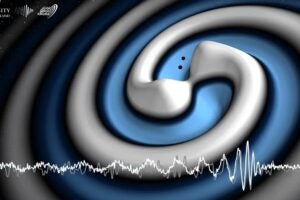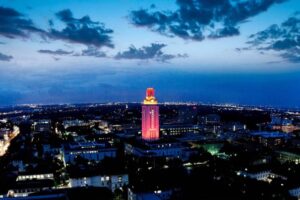AUSTIN, Texas —Scientists seeking to understand the origins of the chemical elements have found important new clues to the methods of production of the element lithium by observing gas clouds between the stars. The discoveries have been published in the June 8 issue of the British journal Nature.
Dr. David L. Lambert, a professor of astrophysics at The University of Texas at Austin and a leading authority on the composition and evolution of stars; David C. Knauth, a graduate student at the University of Toledo at Toledo, Ohio; Dr. Steve R. Federman, a professor of astronomy at the University of Toledo; and Dr. Phil Crane, an astrophysicist at NASA in Washington, D.C., conducted their research at UT Austin’s McDonald Observatory. They used the 2.7 meter Harlan J. Smith telescope and a spectrograph built by Robert G. Tull and Phillip J. MacQueen.
Their research provides novel information on the presence and production of lithium in outer space. Astronomical observations of the ratios and abundance of the elements and their isotopes throughout the universe are used to learn more about the processes by which elements were formed.
“The overall goal of almost all of my work is to discover the origins of the chemical elements,” said Lambert, who holds the Isabel McCutcheon Harte Centennial Chair in Astronomy. “We are trying to understand how the chemical elements were made. The Big Bang that started the universe provided hydrogen, helium and very small amounts of one form of lithium — the isotope Lithium-7.”
“With the exception of the three light elements — lithium, beryllium and boron — all the other elements, we believe, are made in stars by one mechanism or the other. The origins of these light elements — lithium, beryllium and boron — have long been a mystery,” Lambert said.
In the 1970s, Lambert said, scientists proposed the three elements are formed when high-energy particles called cosmic rays smash into carbon, nitrogen and oxygen nuclei in interstellar clouds and break the nuclei up into lithium, beryllium and boron. According to predictions, two forms of lithium produced by this process — Lithium 6 and Lithium 7 — should be found in roughly equal amounts.
But in the very few places where measurements are possible, the two forms of lithium are found in far different ratios. For example, in meteorites, the ratio of Lithium 7 to Lithium 6 is twelve-to-one, not the roughly one-to-one ration predicted if the lithium had been formed by cosmic rays, Lambert said. “This tells us that there is another process making a lot of lithium. That process probably involves stars,” he said.
Scientists conducting the research over the last two winters at the McDonald Observatory discovered for the first time a pair of interstellar clouds in which the ratio of the two forms of lithium was close to one-to-one for Lithium 7 to Lithium 6.
“That’s the prediction of the cosmic ray value,” Lambert said. “This is the first time — in interstellar clouds or in any other stellar source — that the ratio has been found so close to the cosmic ray prediction.
“It’s been known for a long time that cosmic rays were a substantial contributor to the origins of lithium and the other two light elements. Also, the cosmic rays themselves have a ratio of about one-to-one for Lithium 7 to Lithium 6. But this is the first time we’ve seen gas where the cosmic rays dominated production of lithium,” Lambert said.
After earning a doctorate in philosophy in solar physics at the University of Oxford in his native England, Lambert was a research fellow at the California Institute of Technology. He joined the UT Austin faculty in 1969. In 1988, he received the Heineman Prize for Astrophysics from the American Astronomical Society and the American Institute of Physics for setting new standards of precision in the quantitative analysis of the spectra of stars, work basic to the understanding of the evolution of stars and galaxies.
For more information, contact Dr. David L. Lambert of the UT Austin astronomy department (512) 471-7438 or e-mail at dll@mail.utexas.edu, Dr. S.R. Federman at the University of Toledo at (419) 530-2652, or Dr. Philippe Crane, research professor at Dartmouth College and gravitational astrophysicist at NASA in Washington, D.C. (202) 358-0377.



